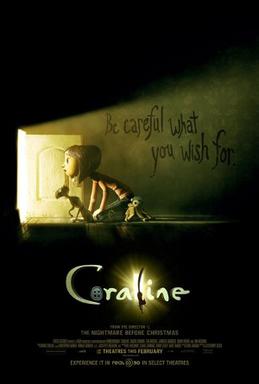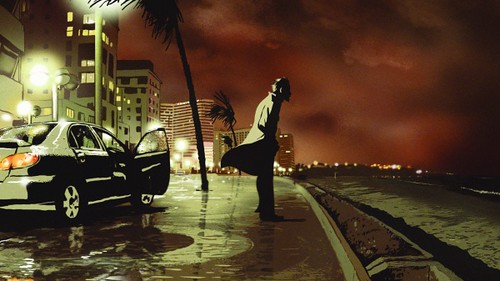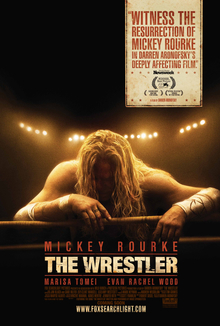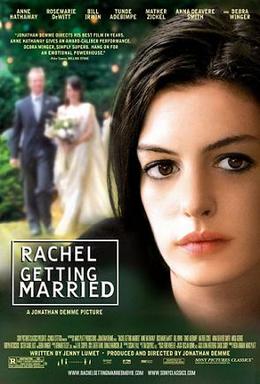 There are very few phrases that will almost always make me avoid a film at all cost. "Torture porn," "based on the hit Broadway musical," "tearjerker" and "starring Paris Hilton" are all certainly among them, along with "romantic comedy." Outside of Annie Hall (and some of Allen's other films if they can be accurately described as such), I can never think of a rom-com that I actually enjoy, which is why it felt so strange to actually be excited by the trailer for 500 Days Of Summer. A romantic comedy that actually looks funny? And smart? And doesn't feature Mathew Mcconaughey or Katherine Heigl? Holy shit. Add in the extremely positive buzz and Joseph Gordon-Levitt and Zooey Deschanael as the leads and it became one of my most anticipated films of the summer, so when I found out that I could get free tickets to an advance screening, I jumped at the chance. Thankfully, it met every expectation.
There are very few phrases that will almost always make me avoid a film at all cost. "Torture porn," "based on the hit Broadway musical," "tearjerker" and "starring Paris Hilton" are all certainly among them, along with "romantic comedy." Outside of Annie Hall (and some of Allen's other films if they can be accurately described as such), I can never think of a rom-com that I actually enjoy, which is why it felt so strange to actually be excited by the trailer for 500 Days Of Summer. A romantic comedy that actually looks funny? And smart? And doesn't feature Mathew Mcconaughey or Katherine Heigl? Holy shit. Add in the extremely positive buzz and Joseph Gordon-Levitt and Zooey Deschanael as the leads and it became one of my most anticipated films of the summer, so when I found out that I could get free tickets to an advance screening, I jumped at the chance. Thankfully, it met every expectation.The Annie Hall comment above was no accident, and it's not just the highly literate, fully formed characters, the sense of humor and the repeated references to the films of Ingmar Bergman. While this film is not as insightful when it comes to relationships as Allen's masterpiece, it is the closest any film this generation has come. Tom (Gordon-Levitt) is a writer at a greeting card company, and he believes very strongly in love, fate and finding "the one," which the narrator says was caused by "listening to too much depressing British music and a complete misinterpretation of The Graduate." Summer (Deschanael) is the new receptionist at the office, and she believes that love does not exist, likening it to Santa Clause. On day 1, Tom sees her, and falls immediately head-over-heels, but this isn't where the film begins. First-time director Marc Webb and screenwriters Scott Neustadter and Michael Weber jump around through the 500 days of the title, showing us all of the ups and downs of their relationship, usually in just the right spot. They open around day 300, right after Tom and Summer break up, as Tom's two best friends and his little sister, who is shown to be a far more emotionally mature person than he, try to console him. We see their relationship begin, and even though she always insists that they are just friends, Tom falls in love. This is juxtaposed with post-breakup Tom falling into a pit of depression, trying to find a reason for their breakup, quitting his job and blaming our societal issues with love on "greeting cards, pop songs and the movies." Around day 30, they first have sex, which is followed by a rather amusing, semi-surreal song-and-dance number. After quitting his job, Tom goes to the movies, which, in what is by far the film's best sequence, leads to shot-for-shot homages to the final scene in Persona and the first chess-scene in The Seventh Seal, with Tom and Summer taking the various roles. Later, after meeting at a mutual friend's wedding, for the first time since their break-up, Summer invites Tom to a party at her house, and we see it in split-screen, one side showing what Tom wants to happen and the other showing us reality. Throughout the film, they discuss art, music, film, architecture and every other thing that people hide behind, but they can never really come together and discuss what is happening to them and the state of their relationship, because Tom is right, the conveniences of modernity do stop us from being able to really open up, and unless two people are absolutely perfect for each other, that will not change.
500 Days of Summer is the best American film I've seen this year, but it does have one or two flaws. The first act is one of the most consistently hilarious half-hours I've seen in a film, so, as the second act begins to settle into serious-mode, it slows down a bit. The film manages to avoid most of the Sundance-cliches. It is quirky, but, for the most part, this adds to our love of the characters and is not just for the sake of being quirky. The one exception may be Tom's little sister. Her scenes are pretty amusing, but it almost always feels very forced and contrived when an adult character talks to a child for relationship advice. In all honesty, those are my only complaints. Webb generally avoids the visual flair and lets the characters be the centers of attention, and they are great characters. Both actors give career-best performances (at least from what I've seen from them, which, in Deschanel's case, does not include her widely acclaimed work in David Gordon Green's All The Real Girls) It is impossible not to fall in love with Summer, and not just because she's played by the equally impossible not-to-love Deschanel. She is just an incredibly fun and refreshing presence, plus she loves The Beatles' underrated "Octopus Garden," which had been stuck in my head all week. Tom is the center of this film, and Gordon-Levitt does a great job of humanizing a character that, in the hands of a lesser actor, probably would have come off as just depressing, and maybe kind of creepy. The film's use of music must also be mentioned. It is full of clips from and references to bands that I love, including The Jesus and Mary Chain, Pixies, Belle and Sebastian, The Smiths, Feist, Spoon and Wolfmother. All of this, plus the intelligent and humorous script adds up to what will undoubtedly be remembered as one of the year's best films. 500 Days Of Summer, more than anything else, is a very modern, very great Woody Allen film, and that should be enough to get you to see it when it comes out.
Rating (out of ****): ****









 As a preface to this review, I should probably note that I am a non-practicing Jew who has spent a decent amount of time in Israel and has many friends currently in the Israeli army. I say this because these facts made it very difficult to simply review Ari Folman's Waltz with Bashir on an intellectual level. This was one of the most emotional movie-going experiences I've ever had. This animated documentary (I'll get to that later) is one of the most highly acclaimed films in Israeli history, and was one of my most anticipated films of 2008. It has already won the Golden Globe for best foreign language film and is the front-runner for the Oscar in that category as well as a dark horse in the best animated feature category (although I'd be shocked if anything actually beat Wall-E). When I first heard that this was an animated documentary, I really didn't know what to think. It just sounded like too much of a contradiction, unless you count an animated educational film as a documentary. Waltz With Bashir has advertised itself as the first feature-length animated documentary, and, given the way it is filmed, I agree with that label. The film is centered around a series of interviews and discussions between Folman and others who were with him in the 1982 war with Lebanon. These sequences were first filmed in a studio, and then the animators drew them separately (it was not rotoscoped, like Waking Life or A Scanner Darkly, which is where they animate over the actual image). Then their interviews lead to a story of flashbacks and hallucinations about the war. At first I didn't realize how these could be considered part of a documentary, but I realized that they are no different from the reenactments in The Thin Blue Line, except in that they use a separate medium.
As a preface to this review, I should probably note that I am a non-practicing Jew who has spent a decent amount of time in Israel and has many friends currently in the Israeli army. I say this because these facts made it very difficult to simply review Ari Folman's Waltz with Bashir on an intellectual level. This was one of the most emotional movie-going experiences I've ever had. This animated documentary (I'll get to that later) is one of the most highly acclaimed films in Israeli history, and was one of my most anticipated films of 2008. It has already won the Golden Globe for best foreign language film and is the front-runner for the Oscar in that category as well as a dark horse in the best animated feature category (although I'd be shocked if anything actually beat Wall-E). When I first heard that this was an animated documentary, I really didn't know what to think. It just sounded like too much of a contradiction, unless you count an animated educational film as a documentary. Waltz With Bashir has advertised itself as the first feature-length animated documentary, and, given the way it is filmed, I agree with that label. The film is centered around a series of interviews and discussions between Folman and others who were with him in the 1982 war with Lebanon. These sequences were first filmed in a studio, and then the animators drew them separately (it was not rotoscoped, like Waking Life or A Scanner Darkly, which is where they animate over the actual image). Then their interviews lead to a story of flashbacks and hallucinations about the war. At first I didn't realize how these could be considered part of a documentary, but I realized that they are no different from the reenactments in The Thin Blue Line, except in that they use a separate medium. As the film opens, Folman sits in a bar with an old friend from the war who explains a recurring dream in which he is chased down the street by 26 angry dogs. In Lebanon, they knew he couldn't kill humans, so his commanders made him kill the guard dogs instead, and he sees this recurrent nightmare as his punishment. After this interviews, Folman realizes that he doesn't remember a thing about the war except for one hypnotic flashback where he and two others wake up in the ocean and walk into Beirut, only to see a large crowd fleeing the Sabra and Shatila massacres, in which a large group of Christian Lebanese entered two Palestinian refugee camps and slaughtered the refugees while the Israeli guards just stood by, paralyzed by the chain of command. Folman goes to interview one of the men who was in the dream (he can't remember the other), and, through interviews with him and various others who were there in that time, he begins to put together what happened. Through this, we get a series of fascinating, interconnected vignettes about the war and its effect on people. The only one of these that doesn't work perfectly involves Folman working a VCR so his colonel can watch porn; however this is soon followed by the best scene in the film. As they entered Beirut following the assassination of Lebanese leader Bachir Gemayel (pronounced Bashir), Folman's company faced heavy enemy fire. After a few minutes, his commander knew that they needed to cross the street, so he grabbed a heavy machine gun and walked out, shooting into the air, performing a crazed Waltz amid the gunfire and posters of the fallen leader. Near the end of the film, there is an abrupt switch from animation to archival footage. This scene, aside from showing the true effects of war in far greater detail, perfectly uses the dreamlike imagery of animation to contrast the real, and reminds us of the line between dream, memory and fact.
As the film opens, Folman sits in a bar with an old friend from the war who explains a recurring dream in which he is chased down the street by 26 angry dogs. In Lebanon, they knew he couldn't kill humans, so his commanders made him kill the guard dogs instead, and he sees this recurrent nightmare as his punishment. After this interviews, Folman realizes that he doesn't remember a thing about the war except for one hypnotic flashback where he and two others wake up in the ocean and walk into Beirut, only to see a large crowd fleeing the Sabra and Shatila massacres, in which a large group of Christian Lebanese entered two Palestinian refugee camps and slaughtered the refugees while the Israeli guards just stood by, paralyzed by the chain of command. Folman goes to interview one of the men who was in the dream (he can't remember the other), and, through interviews with him and various others who were there in that time, he begins to put together what happened. Through this, we get a series of fascinating, interconnected vignettes about the war and its effect on people. The only one of these that doesn't work perfectly involves Folman working a VCR so his colonel can watch porn; however this is soon followed by the best scene in the film. As they entered Beirut following the assassination of Lebanese leader Bachir Gemayel (pronounced Bashir), Folman's company faced heavy enemy fire. After a few minutes, his commander knew that they needed to cross the street, so he grabbed a heavy machine gun and walked out, shooting into the air, performing a crazed Waltz amid the gunfire and posters of the fallen leader. Near the end of the film, there is an abrupt switch from animation to archival footage. This scene, aside from showing the true effects of war in far greater detail, perfectly uses the dreamlike imagery of animation to contrast the real, and reminds us of the line between dream, memory and fact. I really can not express my admiration for this film enough. Every little detail was alternatively fascinating and heartbreaking. The animation was both dreamlike and beautiful, perfectly capturing the feel and the themes of the film. The score, which won composer Max Richter best composer at the European film awards, is occasionally overbearing, but otherwise perfect, especially during the main hallucinatory sequence. Folman is a perfect guide for this journey, always allowing the story to come out on it's own, and the interviewees, from his friends to the reporters to the military higher-ups at the end, all give us the exact piece of the puzzle that we need from them. My emotional connection to the people and places in the film certainly helped my personal reaction to the story. I can't deny that, but this is an important film, especially now, and it is something that everyone should see. Waltz with Bashir really is one of the best and most innovative films of 2008.
I really can not express my admiration for this film enough. Every little detail was alternatively fascinating and heartbreaking. The animation was both dreamlike and beautiful, perfectly capturing the feel and the themes of the film. The score, which won composer Max Richter best composer at the European film awards, is occasionally overbearing, but otherwise perfect, especially during the main hallucinatory sequence. Folman is a perfect guide for this journey, always allowing the story to come out on it's own, and the interviewees, from his friends to the reporters to the military higher-ups at the end, all give us the exact piece of the puzzle that we need from them. My emotional connection to the people and places in the film certainly helped my personal reaction to the story. I can't deny that, but this is an important film, especially now, and it is something that everyone should see. Waltz with Bashir really is one of the best and most innovative films of 2008.












 Their "Millionaire" set really does look exactly like ours
Their "Millionaire" set really does look exactly like ours

 Craig and
Craig and 